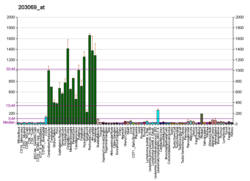Top Qs
Timeline
Chat
Perspective
SV2A
Mammalian protein found in humans From Wikipedia, the free encyclopedia
Remove ads
Synaptic vesicle glycoprotein 2A (SV2A) is a transmembrane protein belonging to a family of keratan sulfate proteoglycans, located on the synaptic vesicles of mammalian neuronal and endocrine cells. It is encoded by the SV2A gene.[5][6][7]
SV2A is the most widely expressed isoform of the SV2 family (which also includes the SV2B and SV2C proteins) found in all brain regions.[8] The role of the SV2 proteins is not well understood; however, they are thought to be involved in regulating vesicular processes.[8]
The SV2A protein is a target of the anti-epileptic drugs (anticonvulsants) levetiracetam and brivaracetam[9] but it is not clear how these drug affect SV2A activity.[10]
Remove ads
Localisation
SV2A is differentially expressed in both inhibitory GABAergic and excitatory glutamatergic terminals[11] however it is not expressed in all synapses[12] as was previously thought.[13] There is a slightly stronger colocalisation between SV2A and GABA than glutamate[14] and the association differs across brain regions and changes with developmental stages.[15]
SV2A PET
Several PET radiotracers targeting SV2A have been developed, allowing for measuring SV2A density in-vivo: [11C]LEV, [11C]UCB-A, [11C]-UCB-H, [18F]UCB-J, [18F]Syn-VesT-1, [18F]Syn-VesT-2, and [18F]SDM-16. SV2A density has been used as a proxy for measuring in vivo synaptic density.[16][17][18][19] A 2024 systematic review and meta-analysis of [11C]UCB-J PET studies reported lower SV2A binding in individuals with psychotic disorders compared with healthy controls.[20]
Remove ads
See also
References
Further reading
External links
Wikiwand - on
Seamless Wikipedia browsing. On steroids.
Remove ads





